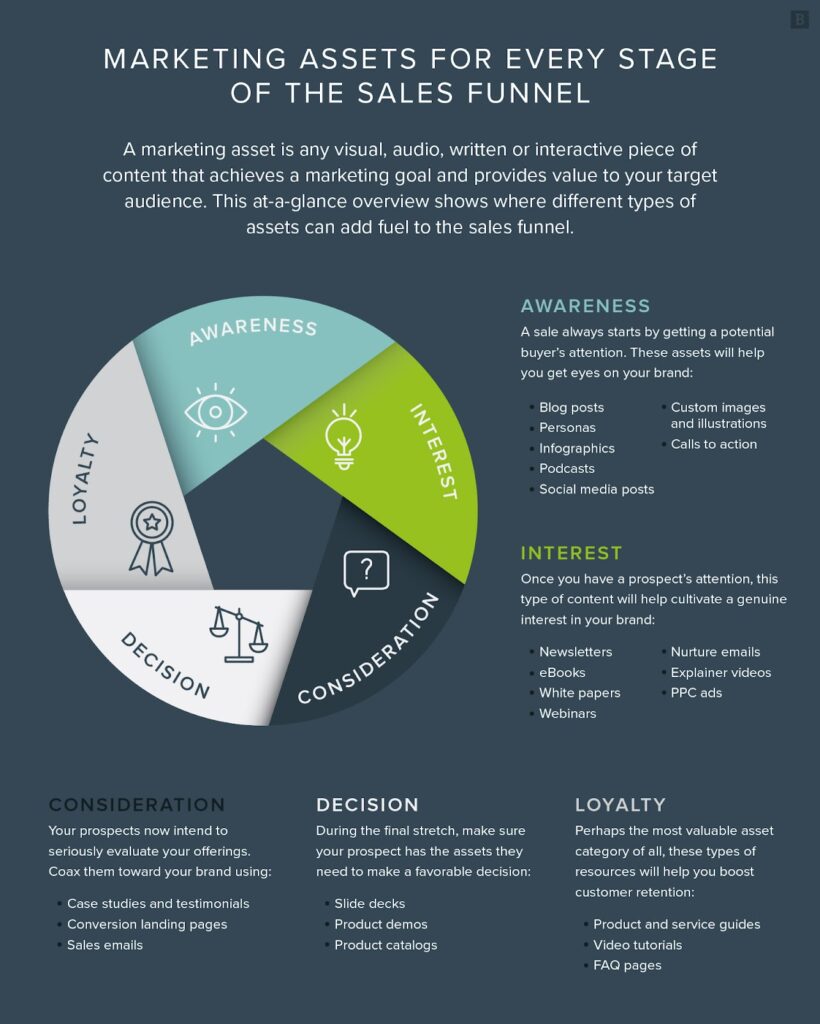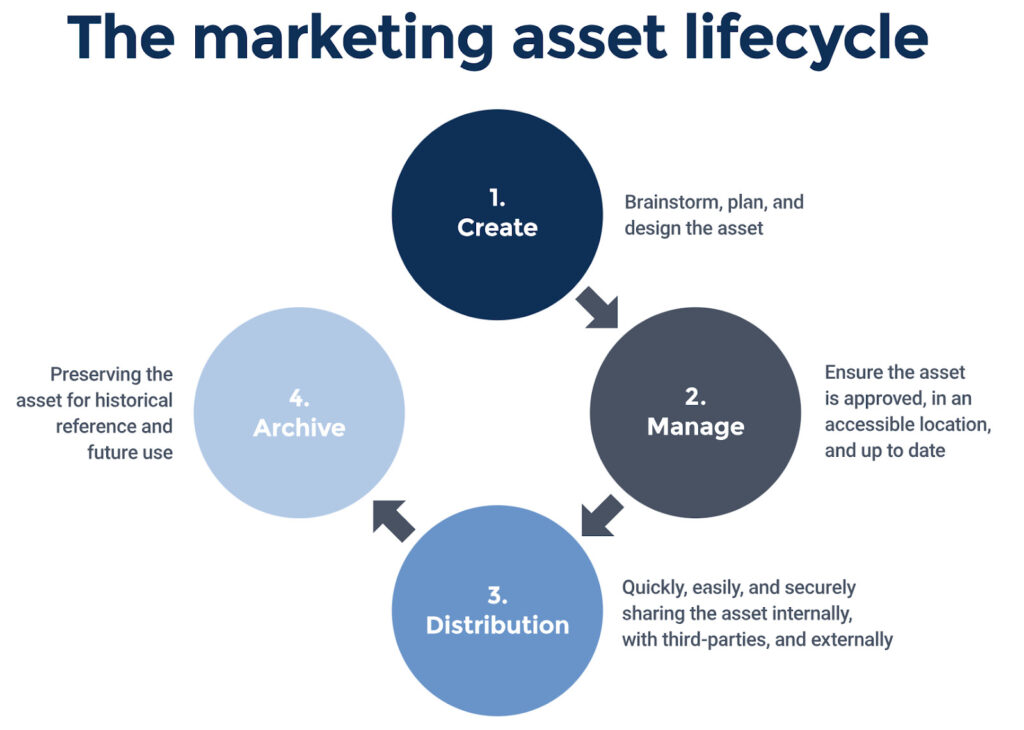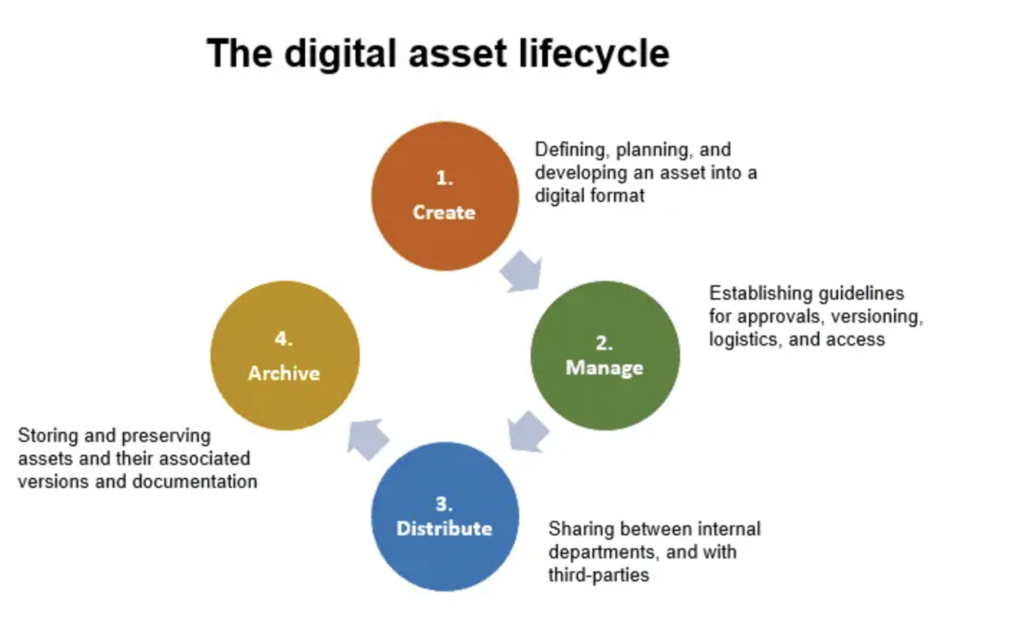Handling the constant growth of marketing assets is important in today’s rapid marketing environment. Without the proper management, you might spend hours searching for a specific asset that’s gotten lost in the endless amounts of digital files. You can solve this struggle with marketing asset management. Think of this software as the expert crew that efficiently categorizes, organizes, and distributes your marketing materials.
This blog will be your ultimate guide on everything marketing asset management related. Additionally, we’ll provide best practices and tips to help you secure a smooth and effective implementation.
What Are Marketing Assets?
Marketing assets are valuable items or resources used by businesses to promote their products, services, and brand to their target audiences. They are tools and content pieces leveraged to communicate the brand’s value proposition, engage customers, and drive sales. This can include digital assets, content assets, brand assets, and more.
Some digital assets examples include:
- Emails
- Brochures
- E-books
- Blog posts
- Website content
- Logos
- Videos
- Images

What Is Marketing Asset Management?
Marketing asset management refers to the processes, systems, and strategies used by organizations to organize, store, retrieve, and distribute their assets in marketing, giving them complete control of their assets. It ensures that all marketing materials are consistent, up-to-date, and easily accessible to various stakeholders, including marketing teams, sales representatives, partners, and other relevant personnel.
A marketing asset management system streamlines the organization of essential digital materials and files, ensuring assets are readily accessible for use and reuse. This minimizes the time spent searching for assets or original files.

Why Is Marketing Asset Management Important?
Marketing asset management plays an essential role in shaping a company’s outreach and image. At its core, marketing asset management revolves around organizing and optimizing a brand’s resources, ensuring they’re used to their fullest potential. This not only ensures that the brand’s messaging remains consistent across different platforms and campaigns but also makes work more efficient.
When assets are easily accessible and well-managed, teams can work more cohesively, reducing redundancy and ensuring that they always have the right resources at their fingertips.
Moreover, in a world where brands are continuously competing for attention, mistakes or misrepresentations can be costly. Using outdated or incorrect assets can lead to compliance issues or miscommunication in the market. Marketing asset management ensures that only the most relevant and approved materials are circulated.
As businesses grow and their asset library expands, the significance of having a streamlined system in place becomes increasingly clear. It’s not just about organization; it’s about ensuring that every piece of content, every asset, aligns with the brand’s goals and resonates with its audience.
Still not convinced on how important an asset management tool is? Find out the Five Signs You Need a Digital Asset Management Tool now.
Internal Marketing Assets
Internal marketing assets refer to materials and resources used within an organization to communicate, promote, and reinforce the company’s values, mission, culture, and objectives among its employees. These are assets belonging to your company, accessible to your internal team, collaborators, and stakeholders.
Examples of internal marketing assets include:
- Training manuals
- Brand guide
- Cheat sheets
- Internal newsletters
- Internal surveys
- Competitive sell sheets
- Onboarding kits
External Marketing Assets
External marketing assets are materials and resources used by organizations to communicate, promote, and position their brand, products, or services to their target audience and the broader public. These assets belong to your company and are available for your audience’s use.
Examples of internal marketing assets include:
- Emails
- Brochures
- E-books
- Blog articles
- Logos
- Videos
- Images
- Audio podcasts
- Website content
- Infographics
- Social media
- Advertisements
- Annual report
- Business cards
- Merchandise
- Promotional videos
- Packaging
- Mobile apps
Who Uses and Benefits From Marketing Asset Management?
Marketing asset management is primarily used by businesses and organizations to centralize, organize, and distribute their marketing materials effectively. Within these entities, several teams and departments use marketing asset management software:
- Marketing teams
- Sales and business development teams
- Creative and design teams
- Communications teams
- IT Departments
- External partners and agencies
Anyone involved in creating, distributing, or using marketing materials within an organization can benefit from and might use a marketing asset management system.
Benefits of Marketing Asset Management
As businesses grow, keeping track of your asset library, from images to flyers, becomes a real challenge. That’s where marketing asset management software steps in, a must for marketers navigating countless (and growing) assets. Marketing asset management isn’t just about keeping things tidy; it’s about making every interaction with your audience spot-on. Here are some of the game-changing benefits of marketing asset management:
Improve Workflows
With marketing asset management software, the entire process of creating, updating, and distributing assets becomes streamlined. No more searching through endless folders or juggling multiple versions of the same file. The software provides a logical flow, guiding teams from the beginning of an idea through to its final execution. This results in a smoother, more efficient process, enabling teams to focus on creativity and execution rather than getting held back and struggling with administrative tasks.
Maintain Brand Consistency
Consistency is the foundation of effective branding. Marketing asset management software ensures that every digital brand asset, whether it’s a logo, color scheme, or key messaging, is standardized. This ensures that no matter where your brand is represented, it maintains a uniform and recognizable identity. This consistency strengthens brand recall and trust among your audience.
Smooth Collaboration
Gone are the days of endless email threads and missed communications. With the collaborative features of marketing asset management software, teams can seamlessly work together on assets. Feedback, edits, and approvals can all be managed within the platform, ensuring that everyone is on the same page and reducing the risk of errors or miscommunications.
Repurpose Content
With a marketing asset management tool, you can make old content new again. Instead of reinventing the wheel, teams can easily search for and locate past assets, tweak them as needed, and repurpose them for new campaigns or platforms. This not only ensures a consistent brand voice but also maximizes the value of each piece of content created.
Centralize Assets and Access
Think of marketing asset management software as your digital library. Every asset, whether it’s a video, image, or document, is stored centrally. With the desired access controls and permissions, internal and external stakeholders can be authorized to access what they need, when they need it, from wherever they are. This centralized system eliminates the chaos of messy assets and ensures everyone uses the latest, approved versions.
Increase ROI
A marketing asset management tool will ensure your teams can access your valuable assets all in one location, keeping them organized and easy to find. Improved search capabilities and AI features, such as AI tagging and AI content assist help cut content creation time. This means you can get your content to your audience quicker and significantly shorten your content pipeline. In turn, this helps companies achieve a better return on their marketing investments.
Save Time
Time is a precious commodity. With a well-structured marketing asset management system, the time previously spent searching for assets, confirming their versions, or waiting for approvals gets drastically reduced. This efficiency means you can spend more time doing what you do best: crafting compelling strategies and content.
Marketing Asset Technology and Tools
Marketing asset management technology and tools have revolutionized the way businesses handle and distribute their marketing collateral. However, with so many tools out there, it can get confusing figuring out which one you need and what all the acronyms stand for. Let’s take a look at some of the popular marketing asset technologies and tools.
What’s the Difference Between Marketing Asset Management and Digital Asset Management (DAM)?
Marketing asset management tools share similar features with digital asset management (DAM) tools, however, the main distinction is in the kind of media they oversee and their relevance to specific sectors. While marketing asset management focuses on marketing operations, DAM has a broader application, serving as a digital library for various organizational needs.
Industries centered around marketing tend to find more value in marketing asset management systems. On the other hand, sectors like architecture, engineering, and construction (AEC) and real estate often find DAM systems more fitting for their needs.
Digital Asset Management (DAM):
- Focus: A broader tool that manages a wider range of digital assets across different departments of an organization. Emphasizes asset categorization, versioning, access control, and distribution.
- Purpose: Primarily handles the storage, organization, and retrieval of digital files. Manages a wide array of digital files, including images, videos, documents, and more.
- Users: Broader in scope, catering to the needs of various departments and industries beyond just marketing. This includes technology, education, real estate, construction, engineering, architecture, design, manufacturing, marketing, retail and e-commerce, nonprofits, hotels and resorts, tourism, and local government.

Marketing Asset Management:
- Focus: Tailored specifically for the marketing world. It’s about managing the lifecycle of marketing materials from creation to distribution. Often includes tools for collaboration, campaign management, and brand consistency.
- Purpose: Typically handles marketing collateral such as brochures, advertisements, promotional videos, and brand guidelines.
- Users: Used by marketing teams to ensure that materials are on-brand, up-to-date, and easily accessible for campaigns and promotions.
What’s the Difference Between Marketing Asset Management and Content Management System (CMS)?
A CMS is tailored for web content creation and management while a marketing asset management system is a broader tool designed for the management of marketing assets.
While both marketing asset management and CMS deal with content, marketing asset management is more about managing marketing-specific assets, ensuring brand consistency, and controlling asset versions. On the other hand, a CMS is geared toward creating, editing, and publishing content on your organization’s website.
Both systems collaborate to make content and asset management smooth for digital marketing experts.
Content Management System (CMS):
- Focus: A CMS primarily handles the creation, modification, and publishing of digital content, typically for websites.
- Purpose: Often manages textual content, embedded images, and web page layouts.
- Use: Used for web content management and enterprise content management, facilitating collaborative work. Examples include WordPress, Joomla, and Drupal.
Marketing Asset Management:
- Focus: Marketing asset management is specialized in organizing, storing, and retrieving marketing assets like images, videos, brochures, and other collateral. It’s primarily concerned with the lifecycle and usage of these assets.
- Purpose: Helps brands maintain consistency across campaigns and channels by centralizing marketing assets and ensuring that teams are always using the most current and approved versions.
- Users: Typically used by marketing teams to ensure that marketing collateral is easily accessible, consistent, and up-to-date.
What’s the difference between marketing asset management and brand management system (BMS)?
While there’s some overlap between marketing asset management and BMS, the key distinction lies in their primary objectives. Marketing asset management is primarily concerned with the organization and accessibility of marketing assets, while BMS focuses on ensuring that all materials and representations align consistently with the brand’s identity and guidelines.
Marketing Asset Management:
- Focus: Marketing asset management primarily deals with organizing, storing, and retrieving marketing assets such as images, videos, brochures, presentations, and other collateral. It’s all about the efficient management of these assets.
- Purpose: Marketing asset management systems are built to ensure that marketing collateral is easily accessible, up-to-date, and consistent across various campaigns and channels.
- Users: Typically used by marketing teams to ensure that marketing collateral is easily accessible, consistent, and up-to-date.
Brand Management System (BMS):
- Focus: While BMS can incorporate features of marketing asset management, its main goal is to maintain brand consistency and integrity across all platforms and materials. It’s about ensuring that all representations of the brand, from color schemes to logos to voice, remain cohesive and true to the brand’s guidelines.
- Purpose: A BMS helps organizations keep their brand representation consistent regardless of who is creating a new asset or material. It helps in building and maintaining a strong brand identity, which is crucial for recognition and trust in the market.
- Users: Marketing teams, design teams, content creators, sales teams, and external agencies.
Marketing Asset Management Best Practices and Tips
Ensuring the smooth operation and effective implementation of a marketing asset management system should be a top priority. Team members need to harness the full potential of a marketing asset management tool. To do this, you should follow certain best practices. From having robust security features to successful training, here are some of the best practices and tips to consider:
Check Integrations
Every tool you use daily should integrate with your asset management tool. As you set up your marketing asset management software, make sure it easily integrates with the existing tools of your business.
Integrating your asset management tool with other enterprise systems, such as content management systems (CMS) or customer relationship management (CRM) tools, allows for a more seamless workflow. This means assets can be easily accessed, updated, and shared across platforms without repetitive manual interventions.
Establish a Naming and Folder Structure
When naming files, it’s crucial to be descriptive, capturing the idea of the content. For instance, a name like “Summer Campaign 2023.jpg” is far more informative than “IMG1234.jpg”. When dates are incorporated, a consistent format such as YYYY-MM-DD ensures chronological sorting. Special characters like, /, *, and ? can sometimes interfere with system processes, so they should be avoided.
Additionally, if a file has several versions, adding a version number ensures clarity. However, it’s vital to maintain consistency in naming conventions across the entire organization. The goal is to make assets easy for someone to find.
The same principles of clarity and organization apply to folder structures. A hierarchical setup, starting with broad categories that narrow down, helps in having structured asset storage. For instance, a folder path might look like “Marketing > Campaigns > 2023 > Summer”. The folder names should be both descriptive and straightforward, ensuring everyone understands their purpose.
Use Data for Asset Performance
Asset performance refers to your digital assets meeting set objectives. With integrated analytics in many marketing asset management platforms, marketing asset managers can track how specific assets perform.
Data and analytics from marketing asset management systems offer insights into this by presenting key metrics like views, downloads, and conversions, among others. This data helps assess how well your assets perform across different channels and campaigns.
You can discover top-performing assets, low performing assets, and strategize on the best ways to use and distribute them. For instance, marketing asset management insights can highlight assets that drive the most user engagement or reveal which ones need to be updated or replaced. This information can also guide decisions on repurposing assets for different purposes.
With these insights, teams can refine their strategies and allocate resources more effectively. This approach lets companies know the true worth of their assets and optimize for the best return on investment.
Perform Regular Audits and Cleanups
Before diving into your marketing asset management implementation, it’s essential to already audit your digital assets. This audit offers a clear picture of your content’s quantity, variety, and location, allowing for necessary cleanups.
Moreover, understanding your content helps set clear goals for your marketing asset management tool and helps in selecting the right vendor tailored to your organization’s specific requirements. Remember, there’s no one-size-fits-all in asset management; the right choice depends on your assets’ scope and your asset management objectives.
Additionally, in the future, it doesn’t make sense to keep assets that won’t be used. Therefore, make sure to schedule regular asset clean-ups. Perhaps every six months, dedicate time to this cleanup. This might include archiving old assets, refreshing outdated ones, or removing duplicate items. Regularly scheduling asset audits ensures continuous relevance and efficiency.
Apply Security Measures and Access Controls
As digital assets grow in importance for companies, their protection from cyber risks becomes crucial. However, adopting a comprehensive security approach helps companies protect their digital assets.
When setting up your marketing asset management tool, it’s essential to define roles and permissions from the start. This ensures that only authorized individuals access specific content, guaranteeing the correct material reaches its intended channel, whether on a local or global scale.
Using role-based access controls in a marketing asset management system adds an extra layer of security and ensures that only authorized team members and stakeholders can access sensitive materials. Companies can further strengthen the safety of their asset management systems by adopting strong measures, including multi-factor authentication, encryption, regular audits, and employee training.
Provide Effective Training and Support
Finally, an effective implementation requires thorough and consistent training for the system. You should consider hiring a marketing asset manager to plan and conduct training sessions.
Consistent training and updates ensure the team remains confident in using the system and understands its complete potential. This could mean sessions on newly introduced features, Q&A forums, or advice and techniques shared regularly.
During the onboarding process, continuous support is key to ensure proper software usage. Make sure that your marketing asset management provider also offers support every step of the way.
Choosing the right DAM
The best asset management solution for your company is one that offers the most practical features for your team and industry. For businesses in the built world, this translates to a project-based workflow, empowering your team to easily locate, store, and share digital assets. It should also strengthen your brand’s presence and assist in crafting top-tier RFP responses to secure more clients.
Designed specifically for firms in the built world, OpenAsset is the preferred project-based DAM solution for AEC and real estate firms across the world. To discover all of OpenAsset’s benefits, schedule a demo.



